Homemade sauerkraut is rich in probiotics, vitamins, and many other nutrients. It can help improve your digestion, boost your immune system, and even lower your risk of certain diseases and aid in weight loss. Aside from all of that it’s one of my favorite vegetables, with its sour, tangy flavor and crunchy texture. Learn to make homemade sauerkraut in a mason jar with this easy tutorial.
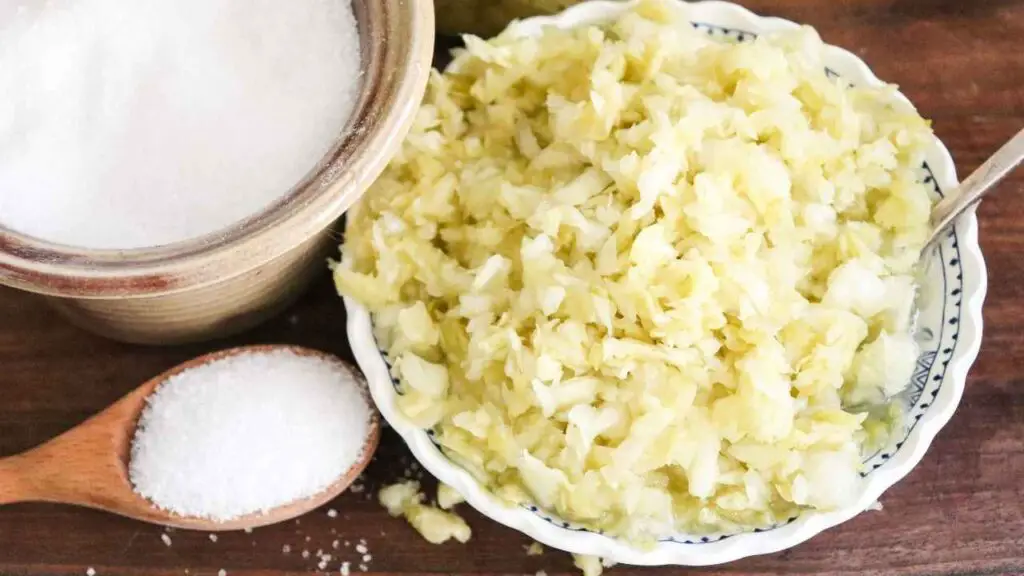
This post contains affiliate links, which means I may make a small commission off items you buy at no extra cost to you. As an Amazon associate, I earn on qualifying purchases. See my full disclosure here.
PIN IT FOR LATER!
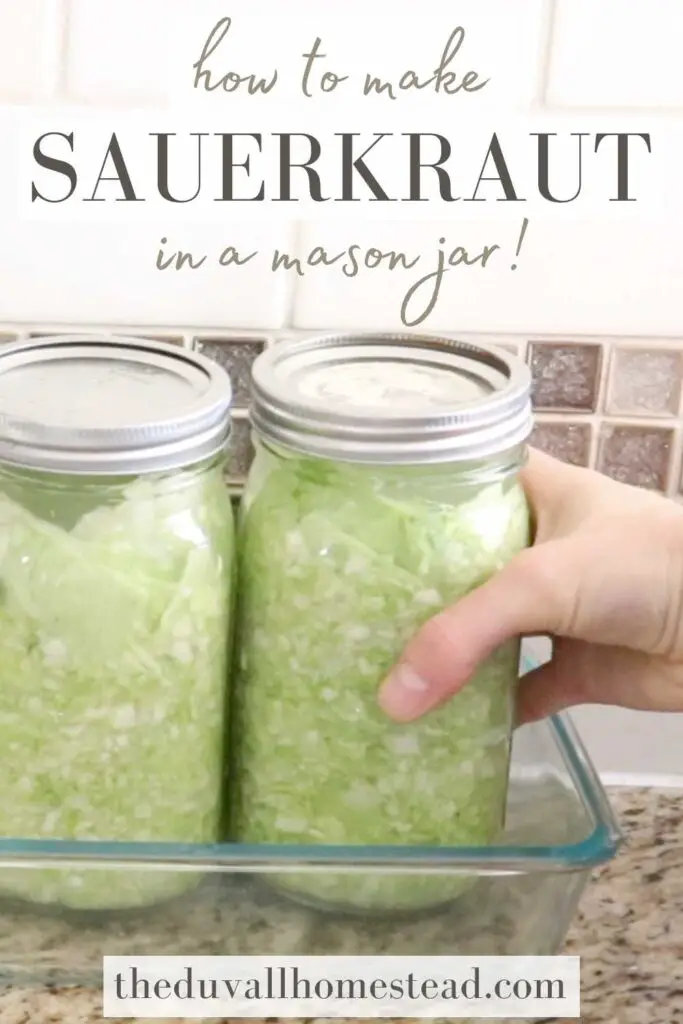
WHAT IS SAUERKRAUT?
Seeing sauerkraut on the shelves at the grocery store may look a bit deceiving. It reminds me of pickle relish or something that would go well on hot dogs and hamburgers.
Sauerkraut is fermented cabbage. You make sauerkraut by slicing up a cabbage, putting it in water with salt, and letting it sit. This process, called fermentation, allows all the good bacteria from the cabbage vegetable to cultivate. This bacteria is also known as probiotics and contributes to our gut health, which provides many health benefits along the way.
When we eat foods that are not fermented, we’re missing out on the bacteria that naturally occurs when you ferment vegetables. This is how food was preserved in ancient times (before refrigerators) and it works just as well in today’s world. Making homemade sauerkraut in a mason jar is a great way to make sure you have a regular source of fermented foods in your diet.
WHAT MAKES FERMENTED CABBAGE HEALTHY FOR YOU?
When you ferment cabbage, you let the bacteria that is naturally present in the cabbage take over. This is a process called lactic acid fermentation and was used many years ago, and still sometimes today, to preserve food.
During lactic acid fermentation, lactic acid increases as sugar decreases, producing a sour and less sweet taste.
Probiotics, which are living microorganisms, are developed during fermentation that didn’t exist previously on the vegetable.
These probiotics contribute to what is called “gut health” in our bodies. Our gut consists of bacteria that helps our digestive system. When this system is out of balance or not working properly, it can spiral into our other systems such as our immune system, nervous system, hormone balance, and so fourth.
The good bacteria coming from sauerkraut can boost the immune system and aid in fighting viruses. This is why having sauerkraut on hand and consuming it often is a very good thing!
I’m not a medical doctor but I was a health coach for a few years after getting a certification in it. I remember learning that there are dozens, if not hundreds, of health problems today that can be traced back to gut health. You can read more about lactic acid fermentation and sauerkraut benefits here.
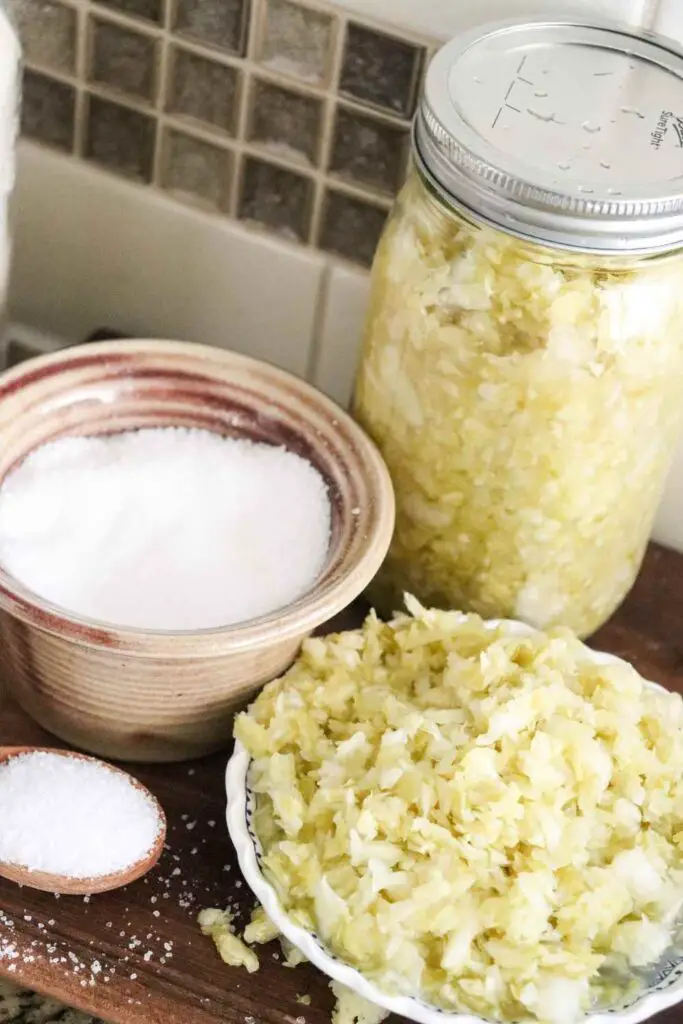
HOW TO MAKE SAUERKRAUT MORE OR LESS SOUR
During the fermentation process, the lactic acid increases as sugar decreases, causing the sauerkraut to taste sour and not sweet.
You can ferment sauerkraut from anywhere from 1-4 weeks, depending on the temperature in your house. The warmer the temperature, the quicker it will ferment.
For a less sour version of sauerkraut, try fermenting only 1 week. For a more sour version, just fermented longer until desired taste is reached.
Also you can add flavors to your sauerkraut if the taste bothers you. You can add spices, herbs, or even sugar. We just prefer it plain and simple.
TIPS FOR MAKING HOMEMADE SAUERKRAUT IN A MASON JAR
- Use fresh cabbage that is organic and made without the use of pesticides or preservatives. If you have a local farmer’s market, that would be a great place to find good cabbage. Always ask them if it was grown organically.
- Use a wide mouth mason jar. You can find these on Amazon in the quart size or 16 ounces. The reason I suggest wide mouth instead of regular mouth is so you can get your hands inside easily. Regular mouth mason jars are too narrow to fit your hands inside which will make this process difficult.
- Use a fermenting weight. You want to make sure the cabbage stays under water in the salty brine, so get a fermenting weight like this one.
- Use the right salt. You want to use a high-quality salt, and not an iodine-rich table salt. We use unrefined sea salt, or pink Himalayan salt. A high quality salt will be reach with minerals from the ocean and perfect for fermentation. You want to aim for about 1 tablespoon of salt per quart of sauerkraut.
- Don’t forget to place your jars in a baking dish. It’s possible that the water, or brine, will overflow out of the jars as the cabbage ferments. So place them in a small baking dish to catch the water to avoid unnecessary clean up!
- Lastly, feel free to use a knife or a food processor to chop your cabbage. Either one works. My food processor tends to yield a small, more fine sauerkraut. So if you like your kraut on the thicker side, use a knife instead.
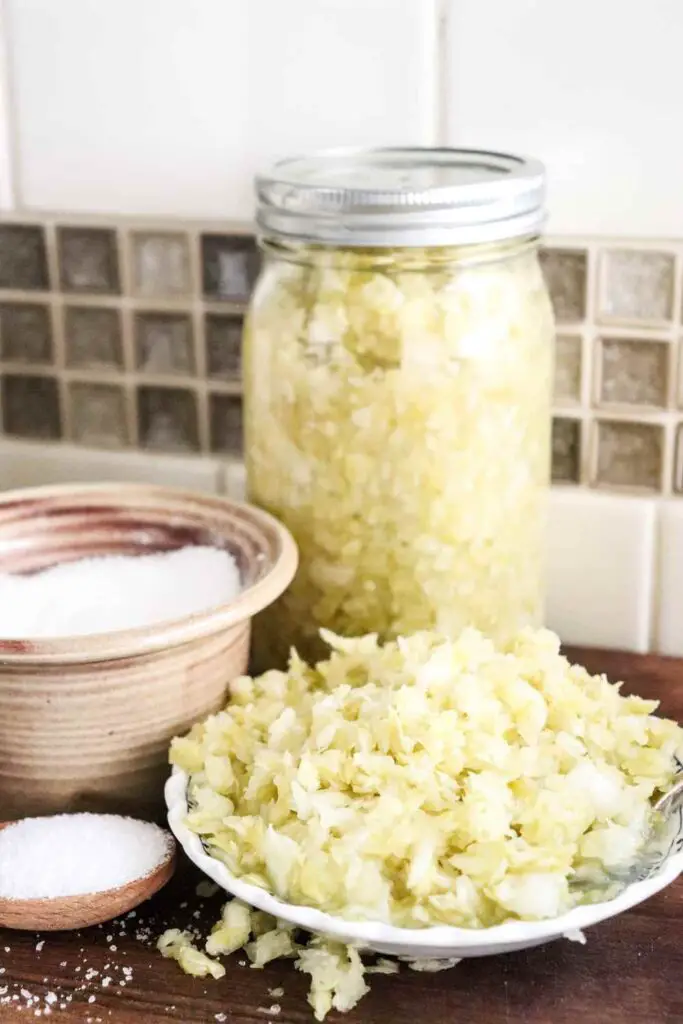
TRADITIONAL SAUERKRAUT DISHES
You’ve made your homemade sauerkraut in a mason jar, but what do you do with it now? Here are some delicious, traditional sauerkraut dishes you could try:
German Sauerkraut and Sausage Knoephla Skillet Dish
Healthy Ground Beef and Sauerkraut Soup
German Sauerkraut Soup with Sausage and Potatoes
Instant Pot Pork Roast with Sauerkraut
German Slow Cooker Pork Chops and Sauerkraut
TOOLS NEEDED TO MAKE SAUERKRAUT
Wide Mouth Mason Jars in quart size or 16 ounces
Baking Dish
Large Mixing Bowls
Cutting Board
Sharp Cutting Knife or Food Processor
SAUERKRAUT INGREDIENTS
This will yield about 2 quarts of sauerkraut.
1-3 organic cabbage, depending on size
2-4 tablespoons of sea salt (not iodized). General rule of thumb is 2 tablespoons salt per quart of sauerkraut.
Filtered water (for extra brine)
HOW TO MAKE SAUERKRAUT AT HOME (MASON JAR METHOD)
First start with an organic, fresh head of cabbage. Rinse off any garden debris in the sink.
Next peel the outer leaves off your cabbage. You’re going to use these later, so try to peel them whole and not ripped. Set them aside.
Then, use the sharp knife to chop the leaves off the cabbage, making your way around the cabbage core. The center of the cabbage is too hard for good sauerkraut, so you want to leave that alone and cut around it.
Place the chopped leaves on a cutting board or in the food processor and chop to your desired thickness. The food processor will yield smaller, finer sauerkraut, or use the knife to chop up big strips of kraut. Place the chopped cabbage in a large bowl.
Add about 1-2 tablespoon of salt per cabbage in the bowl, depending on size. With your hands, massage the cabbage leaves for 5-10 minutes. You will notice a brine (the salty water) starts to form as the salt allows the cabbage to sweat out its moisture. Don’t throw this out! You’ll need it next.
After you’ve squeezed the cabbage leaves for a while, place them packed tightly in your mason jar. Fill no further than 3/4 of the way up the jar.
Pour the salty brine over the cabbage. You want the brine to come up just to the top of the leaves right now.
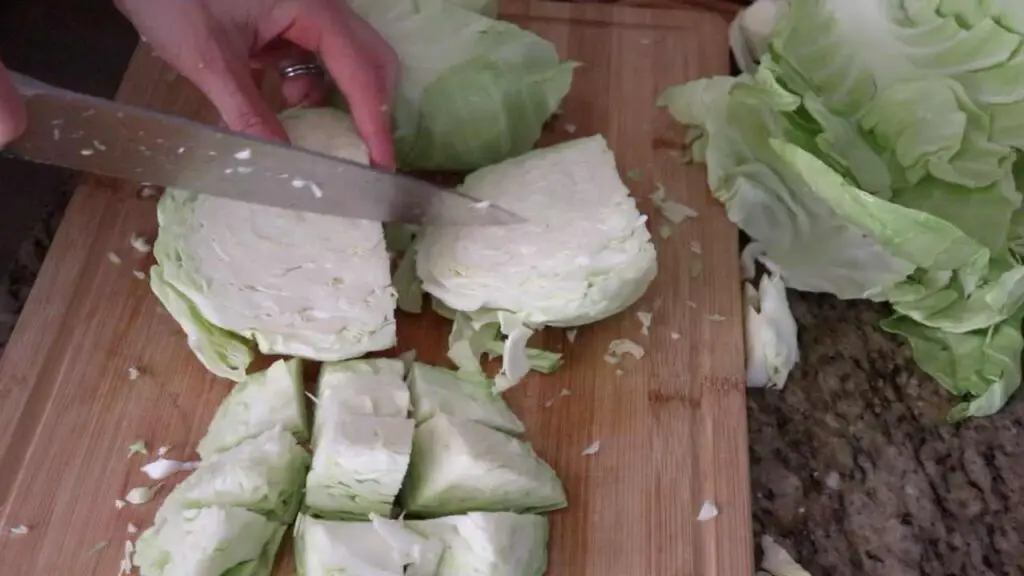
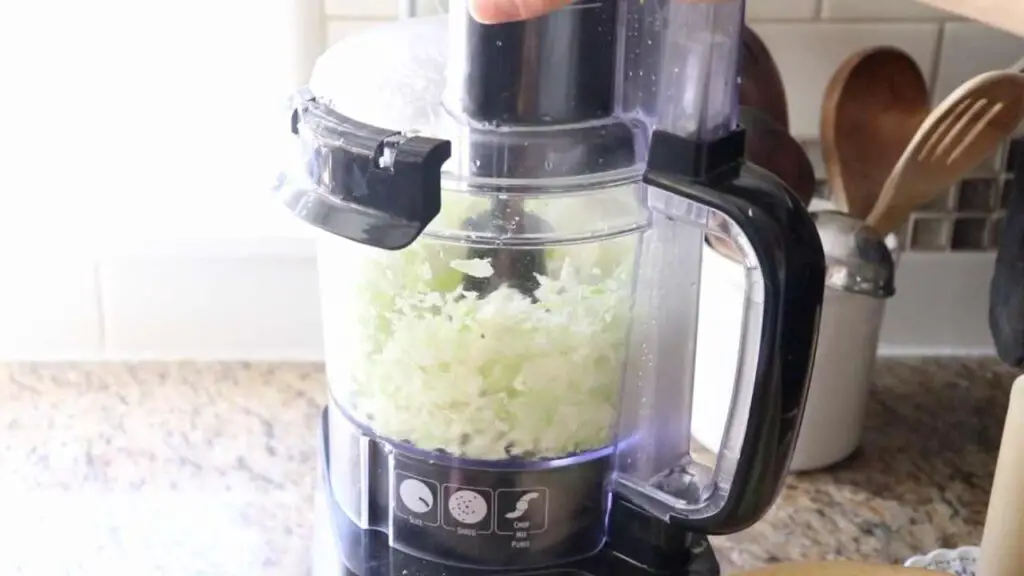
TRADITIONAL HOMEMADE SAUERKRAUT RECIPE, CONTINUED
Take the cabbage leaves you set aside earlier and press them onto of the cabbage in the jar. Press all the way down so that the leaves are compact. Cover the top of the cabbage completely with the leaves.
Now add your fermenting weight. Press down so the weight is submerged below the water. If there is not enough water to submerge the weight, you can warm some water on the stove and add salt, and then pour that in. It will do the same thing as the brine. The general rule of thumb is 2 tablespoons of salt per quart of sauerkraut.
Lastly make sure that everything including the fermenting weight is under water.
Next loosely place the lid on the mason jar, and set the jar in a baking dish on your counter. The sauerkraut will have to let air escape, also known as “burping”, so you can’t seal the jar unless you want to see an explosion! So every few days lift the lid and check on it.
Leave the jars on the counter for 1-4 weeks. I find that 2 weeks is the sweet spot in terms of taste for us. Less time will be less sour, more time will be more sour. You can taste test at week 1, then 2, etc., just make sure to fully submerge it again when you’re done.
Enjoy!
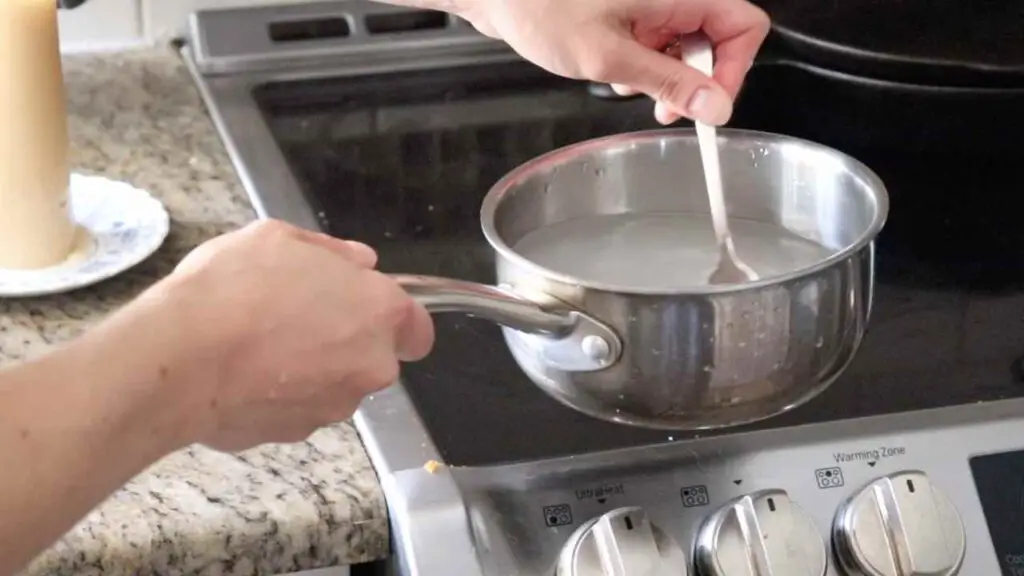
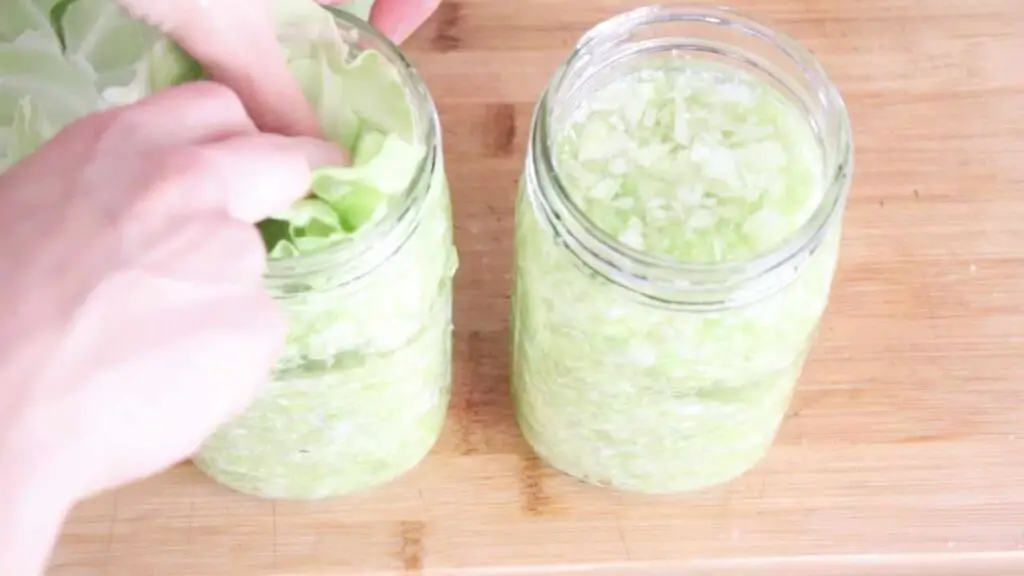
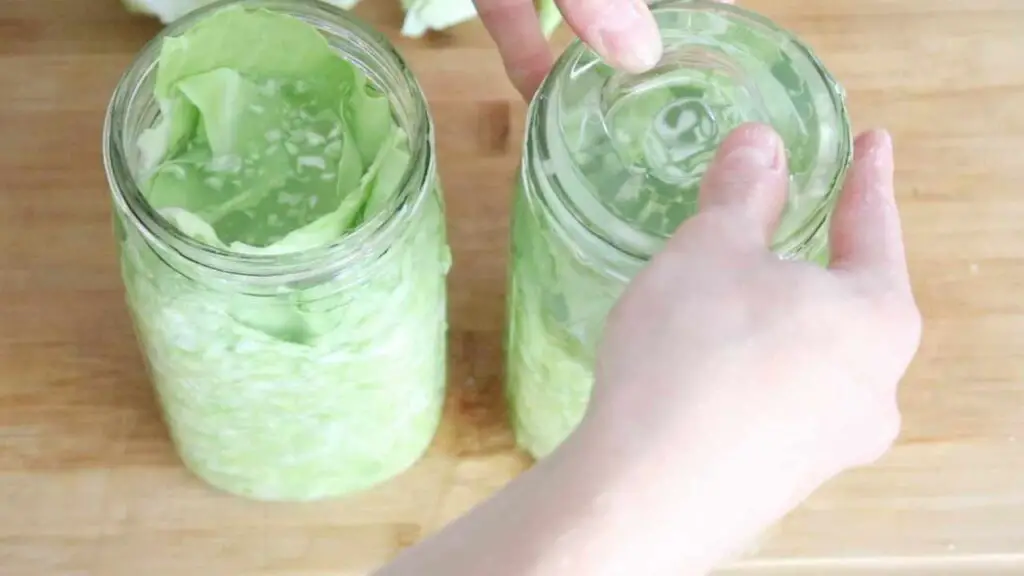
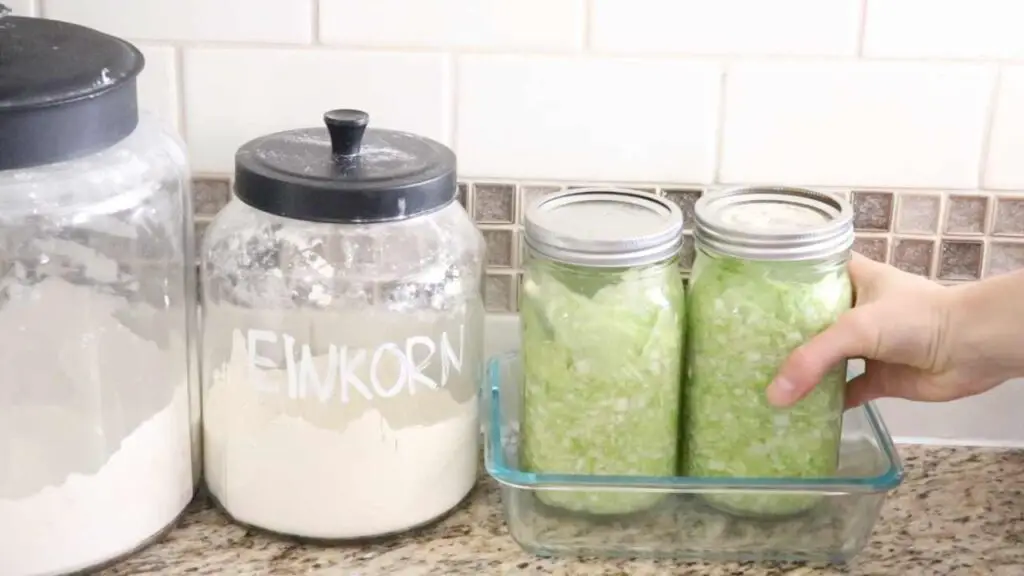
FAQ
Does sauerkraut need to ferment in the dark?
It is best to find a spot out of direct sunlight. If you are concerned about light destroying the bacteria, cover your jar with a towel. Some like to keep their ferments in kitchen cupboards. There is nothing wrong with this, just don’t forget them there in the dark, an easy thing to do!
What other containers are good for making sauerkraut?
Traditional old-fashioned earthenware crocks are another good choice, as long as they are not chipped or cracked. Some would say food-grade plastic works fine as a container but I do not recommend using plastic if you can avoid it. All you really need is a glass jar with a loose lid, so you could even use a plate to cover the jar if you want. Remember, the juices and air need to be able to escape so make sure to have a plate underneath as well.
Should you drain the brine once the sauerkraut is done?
Yes, drain the brine when the sauerkraut is done. Now you technically wouldn’t need to do this because there should be no mold on the brine whatsoever. But I find the sauerkraut tastes better when it’s not super liquid-y.
MORE HEALTHY RECIPES FROM THE HOMESTEAD
How to Make Better Sourdough Bread
No Yeast Sourdough Pizza Crust
Summer Kohlrabi Slaw with Roasted Potatoes
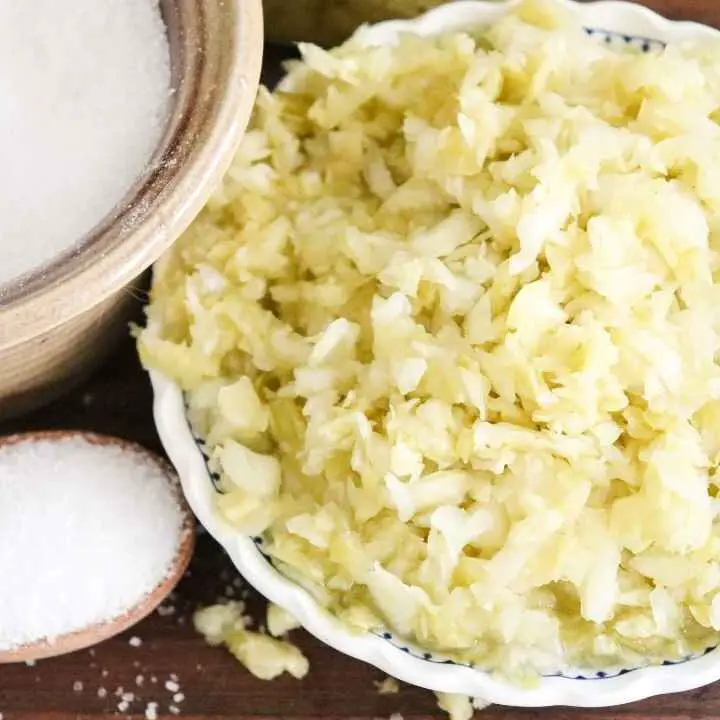
Homemade Sauerkraut
Homemade sauerkraut is easy, healthy, and delicious. Learn how to ferment cabbage in a mason jar for a healthy summer side dish or compliment to hamburgers and hot dogs with this simple tutorial.
Ingredients
- 1-3 organic cabbage, depending on size
- 2-4 tablespoons of sea salt (not iodized). General rule of thumb is 2 tablespoons salt per quart of sauerkraut.
- Filtered water (for extra brine)
Instructions
- First start with an organic, fresh head of cabbage. Rinse off any garden debris in the sink.
- Next peel the outer leaves off your cabbage. You're going to use these later, so try to peel them whole and not ripped. Set them aside.
- Then, use the sharp knife to chop the leaves off the cabbage, making your way around the cabbage core. The center of the cabbage is too hard for good sauerkraut, so you want to leave that alone and cut around it.
- Place the chopped leaves on a cutting board or in the food processor and chop to your desired thickness. The food processor will yield smaller, finer sauerkraut, or use the knife to chop up big strips of kraut. Place the chopped cabbage in a large bowl.
- Add about 1-2 tablespoon of salt per cabbage in the bowl, depending on size. With your hands, massage the cabbage leaves for 5-10 minutes. You will notice a brine (the salty water) starts to form as the salt allows the cabbage to sweat out its moisture. Don’t throw this out! You’ll need it next.
- After you’ve squeezed the cabbage leaves for a while, place them packed tightly in your mason jar. Fill no further than 3/4 of the way up the jar.
- Pour the salty brine over the cabbage. You want the brine to come up just to the top of the leaves right now.
- Take the cabbage leaves you set aside earlier and press them onto of the cabbage in the jar. Press all the way down so that the leaves are compact. Cover the top of the cabbage completely with the leaves.
- Now add your fermenting weight. Press down so the weight is submerged below the water. If there is not enough water to submerge the weight, you can warm some water on the stove and add salt, and then pour that in. It will do the same thing as the brine. The general rule of thumb is 2 tablespoons of salt per quart of sauerkraut.
- Lastly make sure that everything including the fermenting weight is under water.
- Next loosely place the lid on the mason jar, and set the jar in a baking dish on your counter. The sauerkraut will have to let air escape, also known as “burping”, so you can’t seal the jar unless you want to see an explosion! So every few days lift the lid and check on it.
- Leave the jars on the counter for 1-4 weeks. I find that 2 weeks is the sweet spot in terms of taste for us. Less time will be less sour, more time will be more sour. You can taste test at week 1, then 2, etc., just make sure to fully submerge it again when you’re done.
- Enjoy!
Notes
The general rule of thumb is about 2 tablespoons of salt per quart of sauerkraut.
PIN IT FOR LATER!




Leave A Comment